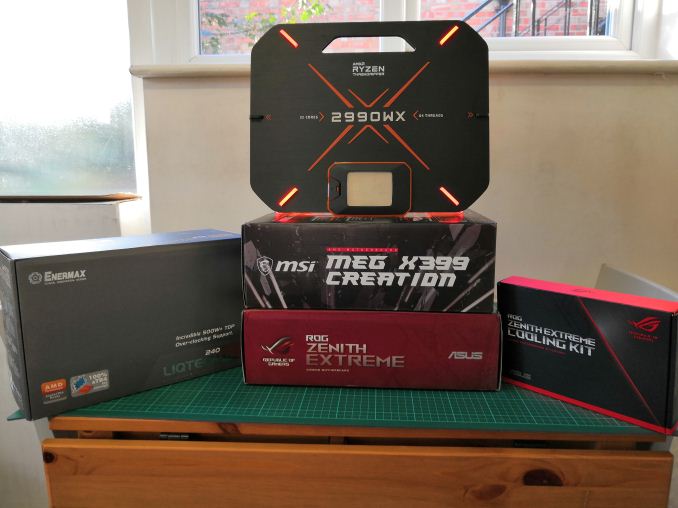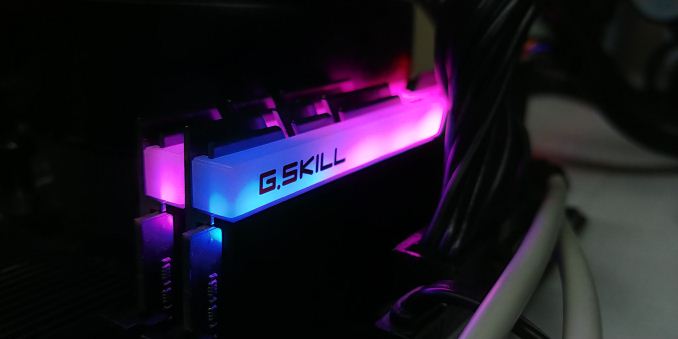The AMD Threadripper 2990WX 32-Core and 2950X 16-Core Review
by Dr. Ian Cutress on August 13, 2018 9:00 AM ESTTest Setup and Comparison Points
In our review kit from AMD, we were supplied with almost complete systems for testing. Inside the box of goods, AMD included:
- AMD Threadripper 2990WX (32C, 250W, $1799)
- AMD Threadripper 2950X (16C, 180W, $899)
- ASUS ROG Zenith Extreme motherboard, rev 2
- MSI X399 MEG Creation motherboard
- 4x8 GB of G.Skill FlareX DDR4-3200 14-14-14
- Wraith Ripper Cooler, co-developed with Cooler Master
- Enermax Liqtech 240 TR4 Liquid Cooler, rated to 500W
For our usual testing, we stick to the same power supplies, the same storage, ideally the same motherboard within a range of processors, and always use the latest BIOS. Despite AMD shipping us some reasonably fast memory, our standard policy is to test these systems at the maximum supported frequency as promoted by the processor manufacturer, or in this case DDR4-2933 for the new Threadripper 2000-series processors.
For our testing we compared the first generation Threadripper processors with the second generation parts. We also have the Intel 18-core Core i9-7980XE, some results from the Core i7-7900X (10-core), and also two mainstream processors, one Intel and one AMD. This is due to our new CPU testing suite, which takes effect today.
Due to an industry event occuring in the middle of our testing, we had to split some of the testing up and take 30 kg of kit half-way around the world to test in a hotel room during Flash Memory Summit. On the downside, it means there is some discontinuity in our testing, although not that much - on the plus side, the hardware tested in the hotel room had a good amount of air-conditioning to keep cool.
| AMD Test Setup | |||||
| CPUs | TR 2990WX | ASUS ROG Zenith | 0078 | Liqtech TR4 | 4x8GB DDR4-2933 |
| TR 2950X | ASUS ROG Zenith | 0078 | Liqtech TR4 | 4x8GB DDR4-2933 | |
| TR 1950X | ASUS X399-A Prime | 0806 | TRUE Cu | 4x4GB DDR4-2666 | |
| TR 1920X | ASUS ROG Zenith | 0078 | Liqtech TR4 | 4x8GB DDR4-2666 | |
| TR 1900X | ASUS X399-A Prime | 0806 | TRUE Cu | 4x4GB DDR4-2666 | |
| R7 2700X | ASUS Crosshair VI Hero | 0508 | Wraith Max | 4x8GB DDR4-2933 | |
| EPYC 7601 | GIGABYTE MZ31-AR0 | Fryzen | 8x128GB DDR4-2666 | ||
| GPU | Sapphire RX 460 2GB (CPU Tests) | ||||
| PSU | Corsair AX860i Corsair AX1200i |
||||
| SSD | Crucial MX300 1TB | ||||
| OS | Windows 10 x64 RS3 1709 Spectre and Meltdown Patched |
||||
The memory for our test suites was mostly G.Skill, with some Crucial. For the EPYC system, Micron sent us some LRDIMMs, so we fired up 1TB of memory to get all eight channels working.
On the Intel side, we are still getting up to speed on our testing.
| Intel Test Setup | |||||
| CPUs | i9-7980XE | ASRock X299 OC Formula | P1.40 | TRUE Cu | 4x8GB DDR4-2666 |
| i9-7900X | ASRock X299 OC Formula | P1.40 | TRUE Cu | 4x8GB DDR4-2666 | |
| i7-8700K | ASRock Z370 Gaming i7 | P1.70 | AR10-115XS | 4x4GB DDR4-2666 | |
| GPU | Sapphire RX 460 2GB (CPU Tests) | ||||
| PSU | Corsair AX860i Corsair AX1200i |
||||
| SSD | Crucial MX300 1TB | ||||
| OS | Windows 10 x64 RS3 1709 Spectre and Meltdown Patched |
||||
Over time we will be adding to our Intel CPUs tested.
Many thanks to...
We must thank the following companies for kindly providing hardware for our multiple test beds. Some of this hardware is not in this test bed specifically, but is used in other testing.
Thank you to Crucial for providing us with MX200 SSDs and to Micron for LRDIMMs. Crucial stepped up to the plate as our benchmark list grows larger with newer benchmarks and titles, and the 1TB MX200 units are strong performers. Based on Marvell's 88SS9189 controller and using Micron's 16nm 128Gbit MLC flash, these are 7mm high, 2.5-inch drives rated for 100K random read IOPs and 555/500 MB/s sequential read and write speeds. The 1TB models we are using here support TCG Opal 2.0 and IEEE-1667 (eDrive) encryption and have a 320TB rated endurance with a three-year warranty.
Further Reading: AnandTech's Crucial MX200 (250 GB, 500 GB & 1TB) Review
Thank you to Corsair for providing us with an AX1200i PSU. The AX1200i was the first power supply to offer digital control and management via Corsair's Link system, but under the hood it commands a 1200W rating at 50C with 80 PLUS Platinum certification. This allows for a minimum 89-92% efficiency at 115V and 90-94% at 230V. The AX1200i is completely modular, running the larger 200mm design, with a dual ball bearing 140mm fan to assist high-performance use. The AX1200i is designed to be a workhorse, with up to 8 PCIe connectors for suitable four-way GPU setups. The AX1200i also comes with a Zero RPM mode for the fan, which due to the design allows the fan to be switched off when the power supply is under 30% load.
Further Reading: AnandTech's Corsair AX1500i Power Supply Review
Thank you to G.Skill for providing us with memory. G.Skill has been a long-time supporter of AnandTech over the years, for testing beyond our CPU and motherboard memory reviews. We've reported on their high capacity and high-frequency kits, and every year at Computex G.Skill holds a world overclocking tournament with liquid nitrogen right on the show floor.
Further Reading: AnandTech's Memory Scaling on Haswell Review, with G.Skill DDR3-3000














171 Comments
View All Comments
T1beriu - Monday, August 13, 2018 - link
> We confirmed this with AMD, but for the most part the scheduler will load up the cores that are directly attached to memory first, before using the other cores. [...]It seems that Tomshardware says the opposite:
>AMD continues working with Microsoft to route threads to the die with direct-attached memory first, and then spill remaining threads over to the compute dies. Unfortunately, the scheduler currently treats all dies as equal, operating in Round Robin mode. [...] According to AMD, Microsoft has not committed to a timeline for updating its scheduler.
Ian Cutress - Monday, August 13, 2018 - link
Yeah, Paul and I were discussing this. It is a round robin mode, but it's weighted based on available resources, thermal performance, proximity of busy threads, etc.JoeyJoJo123 - Monday, August 13, 2018 - link
Maybe just user error, but all the article pages between Test Setup and Comparison Results to Going up Against Epyc, just have the text "Still writing...". I'm unsure if the article is actually still being written and was supposed to be published in this partial manner or if possible something was lost between writing and upload.In any case, kind of crazy how the infinity fabric is consuming so much power. The cores look super-efficient, but if the uncore can get efficiency improvements, that can help the Zen architecture stay even more efficient under load. Intel's uncore consumes a fraction of the wattage, but doesn't scale as well for multiple threads.
Ian Cutress - Monday, August 13, 2018 - link
Still being written. See my comment at the top. Unfortunately travel back and forth from UK to SF bit me over the weekend and I lost a couple of days testing, along with having to take a full benchmark set up with me to SF to test in the hotel room.JoeyJoJo123 - Monday, August 13, 2018 - link
I understand, take your rest. You don't need to reply to me, I actually saw the reason after I posted.compilerdev2 - Monday, August 13, 2018 - link
Hi Ian,I have some questions about the Chromium compilation benchmark, since I was hoping to get the 2990WX for compiling large C++ apps. What version of Chromium is used? Is the compiler being used Clang-CL or Visual C++? Is the build in debug or release (optimized) mode? If it's release mode with Visual C++, does it use LTCG? (link-time code generation, the equivalent of LTO of gcc/clang). For example, if the build is Visual C++ LTCG, the entire code optimization, code generation and linking is by default limited to 4 threads. Thanks!
Ian Cutress - Monday, August 13, 2018 - link
It's the standard Windows walkthrough available online. So we use a build of Chrome 62 (it was relevant when we pulled), VC++, build in release. It's done in the command line via ninja, and yes it does use LTCG.Destructions are here. They might be updated a little from when I wrote the benchmark. Out test is automated to keep consistency.
https://chromium.googlesource.com/chromium/src/+/m...
compilerdev2 - Monday, August 13, 2018 - link
With LTCG those strange results make sense - it's spending a lot of time on just 4 threads - actually majority of the time is on one thread for the Chromium case, it hits some current limitations of the VC++ compiler regarding CPU/memory usage that makes scaling worse for Chromium (but not for smaller programs or with non-LTCG builds). Increasing the number of threads from the default of 4 is possible, but will not help here. The frontend (parsing) work is well parallelized by Ninja, it's probably the reason why the Threadrippers do end up ahead of the faster single-core Intel CPUs. It would be interesting to see the benchmarks without LTCG, or even better, more compilation benchmarks, since these CPUs are really great for C/C++/Rust programmers.Nexus-7 - Monday, August 13, 2018 - link
Cool write-up on the uncore power usage! I especially enjoyed that part of the article.johnny_boy - Monday, August 13, 2018 - link
The Phoronix articles are more telling for the sort of workloads a 64 thread count would be used for.